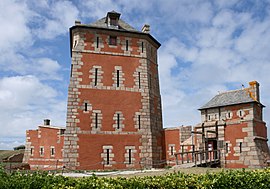Camaret-sur-Mer
Kameled | |
|---|---|
 | |
| Coordinates: 48°16′36″N 4°35′44″W / 48.2767°N 4.5956°W | |
| Country | France |
| Region | Brittany |
| Department | Finistère |
| Arrondissement | Châteaulin |
| Canton | Crozon |
| Intercommunality | Presqu'île de Crozon-Aulne maritime |
| Government | |
| • Mayor (2020–2026) | Joseph Le Mérour[1] |
Area 1 | 11.64 km2 (4.49 sq mi) |
| Population (2022)[2] | 2,448 |
| • Density | 210/km2 (540/sq mi) |
| Time zone | UTC+01:00 (CET) |
| • Summer (DST) | UTC+02:00 (CEST) |
| INSEE/Postal code | 29022 /29570 |
| Elevation | 0–65 m (0–213 ft) |
| 1 French Land Register data, which excludes lakes, ponds, glaciers > 1 km2 (0.386 sq mi or 247 acres) and river estuaries. | |
Camaret-sur-Mer (French pronunciation: [kamaʁε syʁ mɛʁ]; Breton: Kameled) is a commune in the Finistère department in northwestern France, located at the end of Crozon peninsula.
Sights
[edit]
Camaret-sur-Mer is home to the Tour Vauban or Tour dorée (lit. "Golden Tower"), a historic fortification guarding the harbor and built in 1669–94. In 2008, the Tour dorée was listed as a UNESCO World Heritage Site, as part of the "Fortifications of Vauban" group.
Camaret also is home to a marina and some beaches.
Population
[edit]Inhabitants of Camaret-sur-Mer are called Camarétois.
|
| ||||||||||||||||||||||||||||||||||||||||||||||||||||||||||||||||||||||||||||||||||||||||||||||||||||||||||||||||||
| Source: EHESS[3] and INSEE (1968-2017)[4] | |||||||||||||||||||||||||||||||||||||||||||||||||||||||||||||||||||||||||||||||||||||||||||||||||||||||||||||||||||
Map
[edit]Twinning
[edit]Camaret-sur-Mer is twinned with St Ives, Cornwall, UK.
See also
[edit]- Communes of the Finistère department
- Saint-Pol-Roux
- Parc naturel régional d'Armorique
- "List of the works of Charles Cottet depicting scenes of Brittany"
References
[edit]- ^ "Répertoire national des élus: les maires" (in French). data.gouv.fr, Plateforme ouverte des données publiques françaises. 13 September 2022.
- ^ "Populations de référence 2022" (in French). The National Institute of Statistics and Economic Studies. 19 December 2024.
- ^ Des villages de Cassini aux communes d'aujourd'hui: Commune data sheet Camaret-sur-Mer, EHESS (in French).
- ^ Population en historique depuis 1968, INSEE
External links
[edit]- (in French) Official website
- Base Mérimée: Search for heritage in the commune, Ministère français de la Culture. (in French)
- (in French) more than 500 photos of the Crozon Peninsula
Wikimedia Commons has media related to Camaret-sur-Mer.




